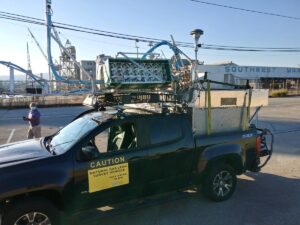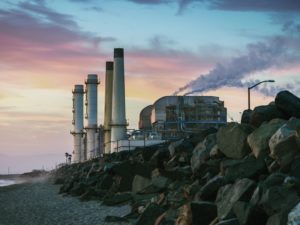Seep Science: Air Quality around Hydrocarbon seeps

Bubbleology Research International (BRI) will be mirroring some content from our new educational website on hydrocarbon seeps. To explore more of these articles, visit: http://seepscience.com.
Air Quality around Hydrocarbon Seeps
Although only some marine seeps release oil and gas, most marine seeps release gas, primarily methane, which escapes more easily from underground rock reservoirs. Methane is a potent greenhouse gas, far more potent than CO2 per molecule. Because of how strong it is, there is a lot of interest in regulating it to reduce climate change. This requires a good understanding of the contribution of methane from natural sources which cannot be regulated. Of the many natural sources, one important one is from geological sources. Intelligent regulations need to account for these natural sources.
Hydrocarbon seeps are a natural geological methane source that is poorly incorporated or even ignored in these budgets. This is in part because few measurements of methane emissions are taken, and in part because of the dynamic nature of seeps. There are land seeps (terrestrial) and also marine seeps – geology doesn’t care whether there’s water or air above it!
Marine seeps constantly change, making it very hard to make good estimates of emissions. For example, emissions vary from factors like swell, seasonal storms, and wind patterns. Long-term measurements are needed to correctly account for these variations, yet very few studies have been long-term.
Different types of bubbles observed coming up from underground reservoirs at the COP seep field (Leifer & Culling 2010). These bubbles are a geological source of greenhouse gases such as methane.
In this regard, the Coal Oil Point (COP) seep field in Santa Barbara, CA has played an important role. The COP seep field gas emissions are primarily methane and lots of it! As such, it was the first seep field for which emissions have been estimated. And the only for which long term data are available. In fact, methane emissions at this seep field are equivalent to 8% of Los Angeles’s man-made methane. This makes it a perfect natural laboratory to measure how geological emissions change with time and what causes these changes.
For example, truly unique long-term data spanning 18 years for the COP seep field has been analyzed. The COP seep field is downwind of an air monitoring station, the West Campus Station (WCS). It lies only 2 km away from the seep field at sea-surface level. In addition to the convenient placement of the station, the COP seep field impacts air quality in surrounding areas and is a great model for improving methane budget estimations. WCS measures emissions continuously, analyzing the air concentration of total hydrocarbons (THCs). Measurements of THCs are often used to estimate methane emissions; methane is a type of THC and the most prominent THC (above 95% for all hydrocarbon gases emitted) at the COP seep field. These data are collected and stored as an hourly average.
This map (Leifer 2019) displays the COP hydrocarbon seep field. It also shows the position of West Campus Station relative to the seep field – right off the coast and in close proximity to the seeps (WCS arrow).
The WCS data displayed patterns of THC concentration that varied daily, seasonally, and yearly. Winds follow a diurnal (daily) cycle – blowing towards shore during the day, and offshore at night. This wind pattern results in high levels of THC in the morning and evening hours, with low and less variable emissions in the afternoon. For example, this cycle creates THC accumulation over the seeps at night and onshore morning winds blow it towards WCS causing high morning THC levels. Seasons also change temperature and weather patterns that affect seep gas emissions. Seasonality was demonstrated by comparing the THC concentration at the same time each day (12:00PM). January had the highest release of emissions, and July had the lowest. These seasonal trends closely followed onshore wind patterns further confirming that wind patterns largely account for changes in seep emissions.
However, wind patterns did not seem to contribute to more long-term scales such as interannual (between years) trends. These yearly changes persist throughout seasons, not following typical seasonal trends. Emissions from the COP seep field decreased through 1990 then they increased through 2008 and have been decreasing since. The exact cause for this trend has been speculated upon; it’s thought to be the result of changes in geologic events. Changes in the deep reservoirs of oil and gas could cause an increase in THC emissions by the sealing or opening of more pathways. Waves, storms, and changes in the pressure of the underground reservoir can also affect emissions (see temporal variability).
This unique long-term analysis of methane (and other hydrocarbons) released at Coal Oil Point reveals the constant variability and unpredictable nature of marine seep emissions. Studies like this one are necessary to improve prediction of methane release and methane budgets used by regulatory agencies. Geologic seeps like these contribute significantly to greenhouse gas emissions, making it pertinent to understand their impact on our global ecosystem.





